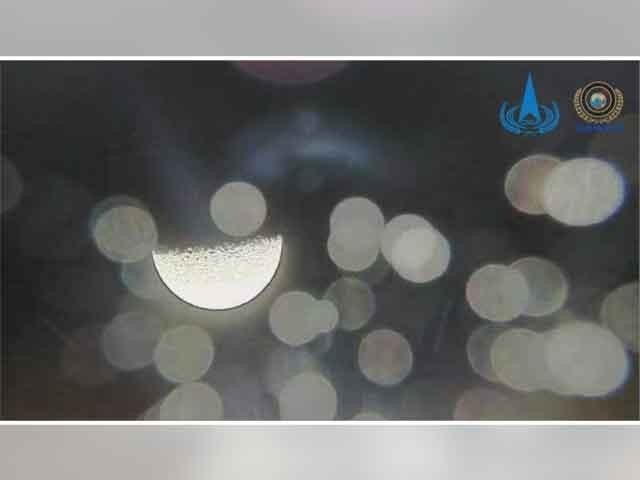——— First image from Moon expected by May 15
——— Three images transmitted via iCube-Qamar so far
——— Satellite completed its rotation in orbit in 12 hours
——— It has made three rounds around moon, says IST
Staff Report
ISLAMABAD: Pakistan’s orbiter ICUBE-Q beamed back on Friday the first image from the lunar orbit, marking a significant milestone in the country’s space programme.
The orbiter successfully entered the moon’s orbit on Wednesday at 1:14 pm PST.
A special ceremony on the successful mission was held at China National Space Administration, during which the Chinese authorities formally presented the first image to Pakistani Ambassador Khalil Hashmi.
The satellite is now in its fixed lunar orbit and is operating within specific parameters. Experts had previously indicated that it may take approximately one week to verify the subsystems before the satellite imaging system becomes operational, after which the first image of the Moon is likely to be received by May 15 or 16.
Meanwhile, China Friday delivered the data to Pakistan captured by its ICUBE-Qamar satellite which was onboard the Chang’e-6 spacecraft, deepening lunar exploration cooperation between the two countries.
The ceremony was presided over by Chief Engineer of the China National Space Administration Li Guoping.
Representatives from the Department of International Cooperation of the China National Space Administration, the Lunar Exploration and Space Engineering Centre, the National Astronomical Observatories of the Chinese Academy of Sciences, Shanghai Jiaotong University, the Space and Upper Atmosphere Research Commission of Pakistan and the Asia-Pacific Space Cooperation Organisation attended the meeting.
At the ceremony, the Lunar Exploration and Space Engineering Centre of China National Space Administration made a report on the mission of Chang’e-6 as the overall project.
The Pakistan Institute of Space Technology also made a report on the development of the payload and international cooperation, and Shanghai Jiaotong University reported on the cooperative development of the payload as the Chinese responsible unit.
The Chang’e 6 mission has entered lunar orbit under the influence of lunar gravity. In the next phase, the Chang’e 6 mission will deploy its lander and ascender to the far side of the lunar south pole.
On June 1, the main lander will detach from the spacecraft followed by Chang’e-6 mission to commence the collection of soil and rock samples from the lunar surface on June 2.
The Chang’e 6 mission is scheduled to commence its return journey on June 4. The mission will dock on June 6, and return to Earth on June 25 upon completion of its 53-day mission as per the program.
Pakistan’s space programme achieved a historic milestone on May 3 as the country’s first-ever lunar orbiter lifted off from China’s Henan Space Launch Site.
The quest to send a lunar orbiter started in 2022 when the China National Space Agency (CNSA), through the Asia Pacific Space Cooperation Organization (APSCO), offered member states an opportunity to send a student-built payload to Earth’s closest celestial neighbour onboard the Chang’e 6 mission.
The ICUBE-Q was submitted as a proposal for a lunar CubeSat by the IST. The proposal was selected after an evaluation process. The development of the payload was a collaborative effort between IST’s students and faculty, SUPARCO and China’s Shanghai Jiao Tong University (SJTU).
The payload consists of three parts, the CubeSat, the separation mechanism, and the mounting bracket. The payload itself weighs around 7kgs. It carries two cameras to take images of the lunar surface and has other sensors and apparatuses for deep-space communication, altitude controls, and other functions.




